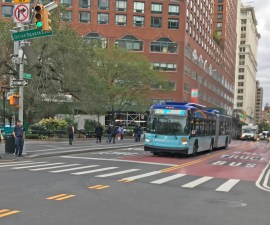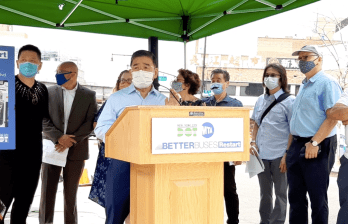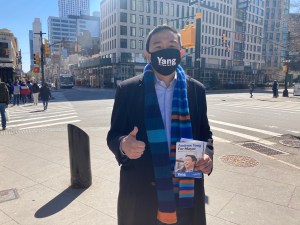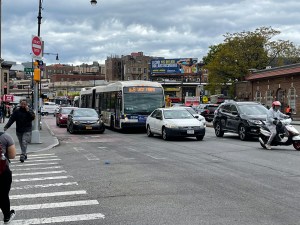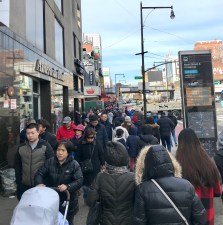Eyes On The Street: The Flushing Busway is Finally in Effect

Seven months after Mayor de Blasio first announced it, after months of pushback and even a court case, the city’s long-stalled Main Street busway finally started rolling on Tuesday.
The car-free .3-mile stretch between Northern Boulevard and Sanford Avenue, where thru traffic is forbidden, got off to a slow start, but it’s an already impressive improvement for a notoriously deadly thoroughfare.
“There were definitely a lot of less cars on Main Street — [the bus] was a lot faster in parts,” said Hsi-Pei Liao, a Queens resident and safe-streets advocate, who tested out the Q44 bus on Tuesday morning. “You could see some improvement. I’m just hoping it’s gonna stay that way; it was a drastic improvement from a typical day.”
Liao, whose daughter was killed by a reckless driver on Main Street and Cherry Avenue, added that he’s grateful the city is finally prioritizing pedestrians and other vulnerable road users over car owners. Liao said the busway would be great for people like his mother, who lives on Main Street, doesn’t own a car and relies on the bus to get around.
“We’re very happy the city is prioritizing public transportation and pedestrian safety over personal vehicles,” said Liao.

But locals will take time getting used to the changes. NYPD traffic agents stationed at either end of the busway, waving drivers to turn off the street, said they hadn’t gotten the message in the busway’s first few hours. One officer at Sanford Avenue said she had to put cones down in the middle of the road to deter people from driving down Main Street after one did anyway.
“They don’t want to listen,” the agent said, frustrated.

One straphanger aboard the Q15 said he didn’t yet notice a difference in terms of his commute time of the bus, but said it took noticeably longer for the bus to actually show up — though the delay could be wholly unrelated to the new restrictions.
And an MTA bus driver said he didn’t notice a difference yet either, telling Streetsblog on Tuesday afternoon that locals need time to get used to it.
“No difference yet, got to let it roll,” he said.
Thanks to our friends at @NYC_DOT, today’s busway launch in Downtown Flushing is a win for customers.
More than 155,000 customers ride the 11 bus routes that use this stretch of Main Street-that’s almost 25% of local riders in Queens!
Get ready for faster speeds & shorter trips https://t.co/JChR0rV0ay
— NYCT Bus (@NYCTBus) January 19, 2021
Day one of the busway, which will serve more than 150,000 commuters daily, comes about two weeks after a Queens judge denied opponents’ request for an injunction on the project — at the same time, nullifying the temporary restraining order he put on the city in November when a lawsuit was filed to stop it altogether.
But Queens Supreme Court Justice Kevin Kerrigan has yet to rule on the merits of the case — which argues that the city does not have the power to create such a roadway without specific legislative approval. Opponents also claim that the busway would have a severe “negative impact” on the community by hurting local businesses since people would no longer be able to drive their private vehicles to the commercial strip. Opponents were joined by Flushing Council Member Peter Koo, who misappropriated Black Lives Matter rhetoric to make his point that “business lives matter.”
But a Main Street busway actually would help local businesses, according to the DOT. According to a 2015 study of shoppers on Main Street, only 17 percent of people arrived by cars, while 27 percent arrived by bus. Even fewer people, just 4 percent, parked on the usually congested corridor in front of a storefront.
A full ruling on the opponents’ suit is pending, but precedent shows its success is unlikely — Article 78 cases brought by opponents of the 14th Street busway and the Central Park West protected bike lane both failed to halt the transit and street safety improvements.
And on Jay Street in Brooklyn, where the city installed in August one of the five busways it promised along with Main Street last summer, the results are so far promising.
According to the DOT’s most recent community advisory board presentation on the Jay Street busway, data from the week of Sept. 28 showed buses on Jay Street are moving faster than 6 miles per hour between Tillary and Fulton streets during the morning and evening rush hours — up from an average of 4 miles per hour for the seven bus routes using Jay Street before the busway rules began on Aug. 31, Streetsblog reported in October.
